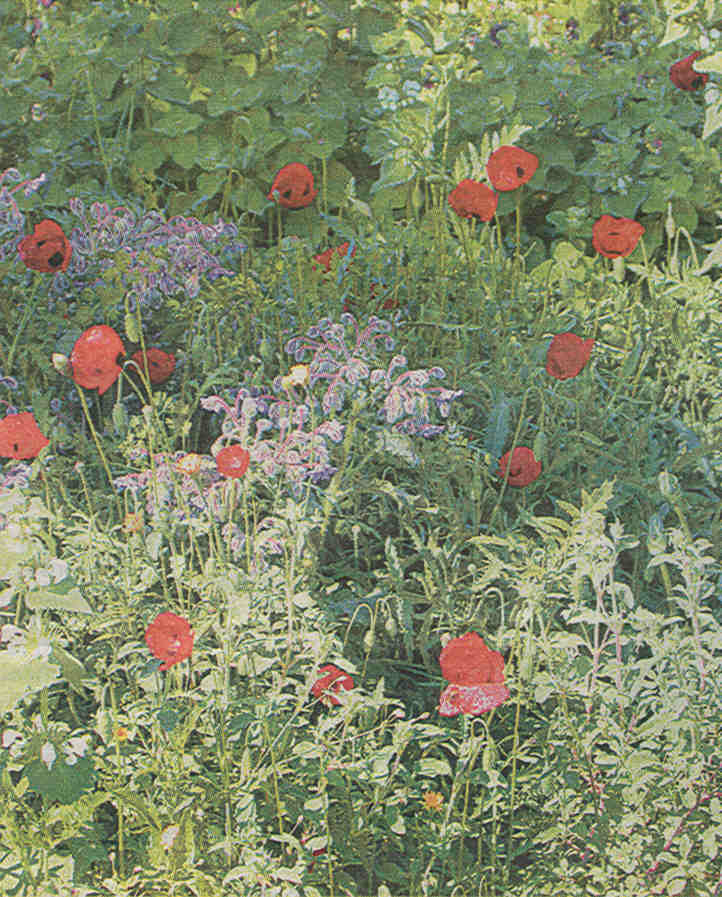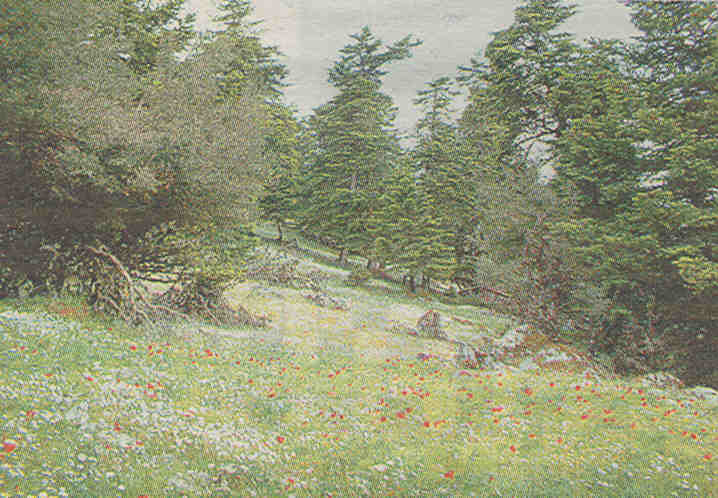 |
||
|
Making a Meadow A colorful tapestry of wild flowers and grasses makes an eye catching and ecologically sound alternative to the thirsty lawn. All it needs to thrive is sufficient sunlight, a little winter rain and low-nutrient soil |
||
|
I've been away working on a landscaping project in the north of Corfu. We are creating some small meadow areas within the project area and I am greatly encouraged by all that is growing around the site. There are plenty of Anemones, Verbascum, Omithogalum (Star of Bethlehem), Pink Catchfly, Muscari and Mustard, all waiting to seed themselves with a vengeance, and I will happily let them do so. This joyful tapestry is, after all, what the Greek spring is famous for. |
 |
|
| ingredients for a Greek spring meadow are poor soil, plenty of sunlight and winter rain. Generally speaking, the poorer the soil, the richer the variety of flowers. Soils rich in nutrients, especially nitrogen and phosphate, encourage certain greedy plants which will take over at the expense of others. Poor soils allow fine grasses and flowers a chance to thrive by limiting the competitive edge of coarse vigorous grasses and weeds. This is why Greece, though generally poor in soil fertility, is rich in wild flowers. We are starting our Corfiot meadow from scratch, so to speak, though we hope that by digging over the soil we will not just have created a seed bed but will also disturb and stimulate seed germination of existing desirable species. When cultivating ground for a meadow, you don't need to dig too deep as this simply encourages deep rooting and more vigorous growth of the less desirables. We have removed aggressive grasses such as couch grass and perennial 'weeds' - it is important to eliminate these before sowing/planting a meadow as they will be much harder to deal with later on. Though it is frustrating to wait, it is also well worth repeating the elimination process a few times over the growing season either with glyphosate (Roundup) or digging them out by hand. We have cultivated the soil by surface tilling, raked it over and rolled the surface to create a fine tilth for seed'sowing. The best time to sow is around midc to late October when you can take advantage of the winter rains to come and also the cold spell that many see.ds like before they germinate. If you miss the autumn slot, an alternative would be mid- to late February when you will hopefully still catch a good few rains to help your meadow along. The danger of the spring sowing is that you will quickly have to support it with irrigation. The great irony of trying to establish meadows in Greece is that we cannot buy mixes of the tapestry of wildflowers around us. This presents some problems but they are not insurmountable. You can collect seed yourself, choosing seed that is suited to your site - whether it be wet or dry, clay or sand or limestone. Most wildflower mixes consist of 80 percent slow-growing grasses and 20 percent perennial flowers - the grasses are very important as they prevent penetration by undesirable weeds. |
||
You might also try 'hay strewing'. The recipient site must have similar soil and geological characteristics to the donar site. The hay is cut in June, baled and transported all in the same day to the area to be seeded. It is important to strew immediately otherwise the seed would start fermenting in the bale. The hay is spread thinly over the site, and should cover an area twice the size it came from. It should be turned regularly to knock the seeds into the soil - after a couple of weeks the hay is removed to stop it smothering the seedlings. |
 |
|
| It is possible to buy seed mixes from the UK consisting of species with a range that extends' across Europe to Greece, but many companies refuse to sell outside the UK on the basis that we should be preserving local populations by using seed of local provenance. The simplest way to create a meadow is by converting an existing lawn, which may well be harbouring interesting flowers and grasses - even the commonest of lawn 'weeds' can look good in flower. It is worth simply leaving an area uncut from February to May to see what appears. Stop using weedkillers and fertilisers, leave broadleaved plants to reproduce and introduce wildflowers as seeds or plants. If you have a very coarse turf or have added lots of nutrients to your lawn in previous years, it is important to lower the competitiveness of lawn species first. To do this, keep it tightly mown for about a year, removing all mowings - don't attempt to plant anything until then. Sowing seed into existing turf is not a very reliable method. In the autumn the turf is cut short, the surface scratched with a rake to remove the thatch leaving patches of bare earth, and seed sown into these patches at a rate of about 1.5 grammes per square metre. The seeds are covered with sieved soil mixed with sand and lightly raked to make sure the seed has good contact with the soil. It is far easier to plant seedlings, perennials and bulbs in drifts to create your meadow, Plant bulbs such as Allium, Iris, Crocus, Field Gladioli, Muscari and Star of Bethlehem according to their season (autumn for spring flowering, late summer for autumn flowering). Perennials such as Chicory, Verbascum, Eryngium and Echinops are best introduced in spring - and it really helps their establishment if an area around them is kept free of weeds for the first couple of years. Ideally, leave the meadow uncut until June to allow the flowers to set seed; mow a path through the meadow in late April c this makes a lovely feature and allows you to easily walk through your meadow. |
||
|
Gardener's query Is it possible to uproot and replant wild cyclamen plants? I found a big patch while on a walk in an Attica wood and was curious if they could survive in pots. I cannot condone collecting plants from the wild and, as far as I know, the picking of cyclamen (a protected species) is illegal. In any case, if you moved cyclamen while in leaf or flower they would be unlikely to flower for a few seasons. The only situation where I'd regard moving plants from a natural situation as permissible is where a new build is about to start - then, if no other plans have been made to rescue in situ flora, it can be treated as a save-and rescue situation. Collecting seed from the wild is acceptable, and raising cyclamen this way is easy (but needs patience). Cyclamen are sometimes available in garden stores in Greece, but many Greek species are cultivated and available from specialist nurseries in the UK -who will ship to Greece. Sent as dormant corms, there will be no problem with them travelling by post. Look for Cyclamen hederifoIium (probably- the one you saw flowering in the autumn) and C repandum which flowers in spring from any of the following reputable suppliers: Avon Bulbs + 44 .1460 242t77, www.avonbulbs.com Bloms + 441234 709099, www.blomsbulbs.com Parkers+ 441618481124, www.dutchbuIbs.co.uk If you have a gardening question forJennifer Gay, send it to gardening@dolnet.gr and she will answer one question each week |
||
(Posting Date 23 April 2007) HCS readers can view other excellent articles by this writer in the News & Issues and other sections of our extensive, permanent archives at the URL http://www.helleniccomserve.com./contents.html
All articles of Athens News appearing on HCS have been reprinted with permission. |
||
|
||
|
2000 © Hellenic Communication Service, L.L.C. All Rights Reserved. http://www.HellenicComServe.com |
||

